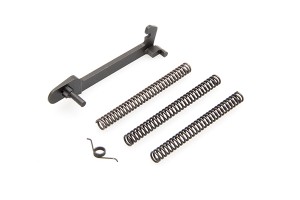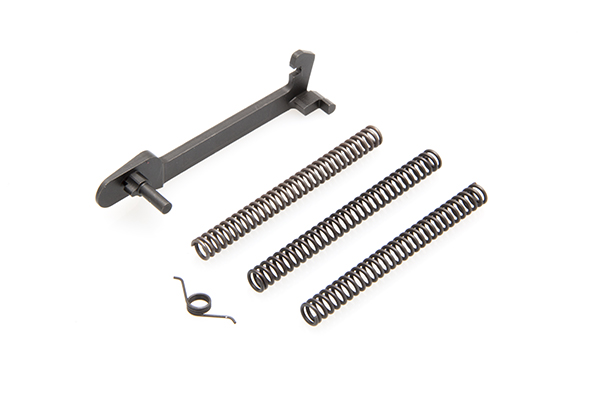If you are a regular reader of the site, you may have deduced that I have a certain fondness for the Beretta 92 pistol. I have used the Beretta 92 quite a bit over the years and the specimens I own have always performed extremely well. The 92 fits my hands nicely. The controls of the pistol all seem to be in just the right place. I’ve never had a feed-way stoppage with a 92 pistol, even when firing the gun in tropical storm conditions with a magazine that was packed with thick mud. The only issue I ever really had with the 92 was that the trigger return spring tended to break frequently if you attempted serious dryfire training. I solved that by installing the Wolff Trigger Control Unit for the 92 family of pistols in my guns.
Even though I like the 92 quite a bit, there are things about it I would change. I vastly prefer the decocker-only G model pistols to the standard FS equipped guns because performing immediate action drills with an FS often leads to unintentional activation of the safety. On one rather embarrassing occasion I didn’t fully seat the magazine when I swapped magazines with the weapon still in the holster prior to a drill and when I got the beep I pulled the pistol and got one shot then a click. I tapped, racked, and went to pull the trigger and got nothing…so I performed the same action three more times. The third time I watched a perfectly good round eject out of the pistol it occurred to me that I had accidentally engaged the safety during the first tap/rack/bang.

The second most commonly complained about feature of the 92 has to be the heavy double action trigger pull. The 92 family of pistols are built largely around the design specifications of the M9 military sidearm. One of the requirements for the M9 is for the weapon to bust extremely hard primers reliably. This means putting a pretty stout main spring/hammer spring (the spring that actually propels the hammer) in the pistol to ensure that the hammer will fall with enough force to reliably set off even the hardest primers. The downside of that kind of ultra-reliable ignition is that the trigger pull has to compress that 20 pound (weight of the spring’s tension, not the spring’s actual weight) hammer spring somehow to cock the hammer. Most Beretta 90 series guns ship from the factory with that ultra-reliable, but very heavy trigger arrangement. Shooters with smaller hands struggle with the combination of the Beretta’s grip and the long, heavy trigger pull made necessary by the military primer requirement.
One of the most frequently performed modifications to the 92 family of pistols is installation of the hammer spring from the double-action-only model Beretta 92D. Often referred to simply as the “D spring”, this spring is rated at 16 pounds and with a standard 92 series hammer still provides reliable ignition with most ammunition even if it wouldn’t pass the military’s stringent primer requirements. It is possible to install even lower weight hammer springs in the weapon, but generally anything below the “D spring” specification would result in spotty ignition reliability. As it goes with most double-action semi automatic pistols, the hammer and the trigger of the Beretta 90 series pistols are joined by a trigger bar. Pulling the trigger pulls the trigger bar forward which, in turn, pulls the hammer backwards until it hits a release point.
Ernest Langdon and the folks at Wilson Combat took a hard look at the trigger bar on the Beretta and thought that if they could modify the design of the trigger bar a bit they could get reliable ignition with lighter hammer springs. I heard tales of this new trigger bar and the excellent trigger pull it could yield for the better part of a year. Then one day back in June I happened to be on the Wilson site looking at getting some new grips for one of my 92 pistols and I saw that they had quietly added the “Action Tune Kit” to the store…including the new trigger bar. I ordered two kits immediately.
Wilson states plainly that some minor gunsmithing is necessary to install the Action Tune Kit, and when I installed the kit on my Wilson Beretta 92 Brigadier Tactical I found that to be true. If you look carefully at the photo at the base of the round pin on the front of the trigger bar (that pin actually runs through the top of the trigger) there is a small protrusion pointing toward where the muzzle of the gun will be. This is an over-travel stop. It bumps into the frame and limits how far forward the trigger bar can go, in turn limiting how far backwards the trigger can go.
I have only tested this part on three 92 series pistols to this point, but based on what I’ve learned from others I think it’s safe to say that at a minimum you will have to fit the over-travel stop for the part to work. As it comes from Wilson, the stop stuck out far enough to prevent the trigger bar from moving sufficiently forward to fully release the sear. Fitting the part to the pistol was simple: File on the over-travel stop with a jewler’s file for a bit to remove some metal, then install it back into the pistol and test the function. The goal is to remove as little of the over-travel stop as possible while still allowing the rear of the trigger bar to reliably release the sear. On my Brig Tac this process of repeatedly filing and checking the fit took less than fifteen minutes.
If you’ve never worked on a Beretta before, here’s a very useful video that demonstrates complete disassembly and reassembly of the pistol. You don’t have to completely disassemble the entire pistol to install the kit, but it shows a good breakdown of removing the grips, the trigger bar, and the trigger bar spring. (DO NOT FORGET THE TRIGGER BAR SPRING!) Be warned: There is chanting and pan-flute music in this video. I strongly encourage watching this with the sound muted and something good playing.
The Action Tune Kit comes with three different hammer springs, weighted at 12, 13, and 14 pounds. This allows you to tune the action for reliable ignition. I had already installed a 13 pound hammer spring in my Brig Tac previously so I left it in the gun when installing the new trigger bar. Having used the pistol with just the 13 pound hammer spring and with the addition of the new trigger bar, I can report that the trigger bar on it’s own made a tremendous difference in the felt weight of the trigger pull. It is the lightest Beretta 92 trigger I have ever used and it’s the lightest true double-action trigger I’ve encountered on any semi automatic pistol full stop. In terms of weight and feel it’s more akin to the lightened triggers you get on H&K’s LEM system or the Sig DAK system than what you would expect on a Beretta 90 series gun.
Because I had the 13 pound spring in the gun before getting the trigger bar, I can also tell you that the new trigger bar improves the reliability of ignition with lighter weight springs. Prior to the installation of the new Wilson trigger bar I experienced multiple failures to fire with just the 13 pound spring in the gun. Since installing the trigger bar I’ve tried multiple types of FMJ and defensive-grade JHP ammunition in the pistol and all have gone bang on the first try.
I’m certain that one of Wilson’s talented gunsmiths could further refine the fit and the overall feel of the trigger, but with minimal skill and minimal time I was able to make a very significant difference in the weight and feel of the trigger by installing one part I’d done a little bit of filing on.
If you like your Beretta, the Action Tune Kit from Wilson is a superb investment. For 80 bucks you can completely transform the trigger in your gun. I’m a very satisfied customer and if you’ve got a 92 that needs some love I think you will be too.

Really, you don’t have a trigger guage to check?
Hi Tim
So I actually installed just the 13# Wilson mainspring in my 92FS, and it has what I consider a decent DA pull now at about 9-10 lbs.
But are you telling me that the Wilson Trigger Bar will make it even better? Maybe I should order one and install it to get an even better improvement.
As I mentioned in the writeup, I had the 13 pound spring in my Brig Tac for a while prior to installing the new trigger bar. Swapping the spring was one of the first I did when I received the pistol, as I was installing the Wilson mag guide in the gun anyway. The spring alone made a difference, but came at the price of unreliable ignition. I experienced several failures to fire using the 13 pound spring on its own. Since installing the new Wilson trigger bar, the trigger pull is lighter and smoother and ignition has been perfectly reliable. I actually have class with Ernest Langdon at the end of this week and I will be using my Brig Tac as my primary pistol in the class.
Honest question: I’ve had my 92 for about 7 years; only mod was to send it to Tooltech for tritium sights, otherwise it’s stock. I would ideally prefer the G model, but frankly I’ve just decided to ignore the safety function of the decocker. Never had an issue with accidental safety engagement. I’ve had some holsters that took it off “safe” when I drew it, but never had a problem with inadvertently engaging the safety. Is it really worth paying for the mod?
“Worth” is a highly individual calculation. I find that when I attempt to clear malfunctions on an FS gun that I almost always engage the safety in the process. For me, personally, a G conversion is worth it. If you don’t run into that problem then it might not be the most worthwhile modification for you. If you’ve trained hard and found that it’s just not a problem for you, rock on. =)
How does one… convert an FS model to G? I know it isn’t a parts swap, but is there a way to have it sent out?
Wilson Combat and Allegheny Gun Works will do it
The controls are in just the right place?
…..?
….even the horrendously awkward slide mounted safety?
I don’t find the operation of a Beretta’s safety to be awkward, personally…and most of my Berettas are G model guns which decock only.